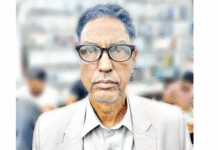Mohammad Tarikul Islam
Good governance is a recent phenomenon which draws upon the concepts from several disciplines such as politics, economics, public administration, law and order and so on. In Bangladesh as in elsewhere, governance either good or bad has become a matter of frequent discussions. It is apparent that traditional government structures and systems of Bangladesh are no longer befitting enough to meet the demands of rising citizen-aspirations and challenges emerging from a host of factors. As a result, the role of the government accepted earlier as the ‘sole provider’ is being questioned.
Governments and governance the world over are undergoing a ‘paradigm shift’ from their traditional roles of control towards result orientation, flexibility, facilitation and a citizen-centric approach. In order to facilitate this shift, e-governance is fast coming up as a vital instrument in a number of developing countries including Bangladesh. It has already demonstrated its strength as one of the most viable devices for advancement of public service delivery with the goal of improving service quality of the government. E-governance can contribute towards promotion of ‘good governance’ by way of ensuring greater civic engagements in the government process.
The ultimate objective of e-governance is to establish good governance. The attributes of good governance can be termed as honesty, efficiency, effectiveness, fair play, reliability, participatory democracy, accountability, accessibility, transparency, equity and a vision in public service delivery system.
Corruption in the public sector has dramatically fallen in the countries which adopted e-governance. A survey in India shows that the states, where e-governance has been established even partially, corruption rate has dramatically come down. The survey found that in Kolkata and Mumbai, due to adoption of e-governance, the corruption rate has considerably declined in some of public sector organisations, to 19 per cent and 18 per cent compared to 51 per cent and 38 per cent respectively in 2000.
E-governance is also an easy tool for the public to be more involved in political processes. It could increase voter awareness, which could lead to an increase in citizens’ participation in elections. It is convenient and cost-effective for businesses, and the public benefits by getting easy access to the most current information available without having to spend time, energy and money to get it.
E-governance helps simplify processes and provides easy access to information. For example, in the US the Indiana Bureau of Motor Vehicles simplified the process of certifying driver’s records to be admitted in court proceedings. Indiana became the first state to allow government records to be digitally signed, legally certified and delivered electronically by using electronic postmark technology. In addition to its simplicity, electronic services can reduce costs.
In Bangladesh, the desk level officers in government offices are not always provided with computer facilities despite the fact that interest about ICTs and ability to learn new technologies is higher among the younger people. Computers have sadly become somewhat of a status symbol in government offices. More than anything else, it is the mindset of government officials that poses the biggest bottleneck to e-governance. There are a number of reasons why they resist the use of computers, some of which are: (1) they are reluctant to embrace any kind of change in their familiar working environment; (2) they fear that computerisation of various activities may make some people redundant; (3) they think that computers are basically meant for typing without much waste of stationary. It is thus seen that even after an IT system is implemented in a government office, it becomes hard to convince the officials of the multifarious activities that can be accomplished quickly and efficiently.
The regulatory/legal framework in many developing countries including Bangladesh has not yet been modernised to accommodate the growing needs of the electronic world. Till today, surprising as it may sound, an e-mail has no official value in government offices and cannot be legally considered as an acceptable mode of communication. In many developing countries; there are no laws to protect against cyber-crime, neither are there laws for electronic authentication. In most of the developing countries, following initiatives are not found to be in place to promote e-governance for rapid and transparent public delivery services:
- National E-governance policy
- Sector specific e-services (both at national and local level)
- Enactment and enforcement of Right to Information Act
- Online citizen services
- Online legal services
- Mobile governance
- E-governance resources
- Public Utility Forms
- Discussion forum
Investment should be made on building ICT infrastructure throughout the government machinery, keeping in mind that the returns from such investment will be long-term. Stand-alone computers (i.e. those that are not connected in a network) are not very useful for e-governance. There should be plans for computers to be connected internally in offices through Local Area Network, and then inter-connected with other relevant offices through Wide Area Network.
The practice of providing computers to only high-level officials needs to be reconsidered. It is the younger officials who are more enthusiastic about ICTs and, more likely to find more creative use of computers and even train themselves in basic handling of computers. Mid-to-lower level officers should be given access to computers. This would be a good way of investing into the future, of preparing the government officers who will take the lead in future. There should be some kind of incentive structure for the promoters of IT in the government. There should be planned training programmes to orient officers for using computers and more importantly, to develop awareness about the potential of IT.
It is now evident that government policy updates are to be entrusted with the flow of e-governance towards transforming the whole relationship between the public sector and users of public services. Hence, time has come to utilise the opportunity to redesign the mode of public service delivery introducing e-governance in all aspects. To address these problems, governments belonging to the developing countries can attempt to streamline service delivery and bring greater speed, certainty and transparency to the process.
Electronic Service Delivery is one way governments attempt to deliver services directly to the citizens without the citizen having to go to a government agency. Electronic Service Delivery can look like any other shopping or service sites on the internet. This requires for preparation of an inventory of existing applications/packages in use by different ministries/departments and corporations facilitating e-governance.
Bangladesh has duly endeavored for renovation of public service delivery as it is evident from United Nations commissioned e-Government survey in 2012 pointing out that many countries including Bangladesh have already put in place e-government initiatives and information and communication technologies for the people to further enhance public sector efficiencies and streamline governance systems to support sustainable development. However, a lot has to be done to gain tangible benefits in the times to come.
The writer is PhD researcher, Department of Government and Politics, Jahangirnagar University. tarikul.islam81@gmail.com
Source: Financial Express









